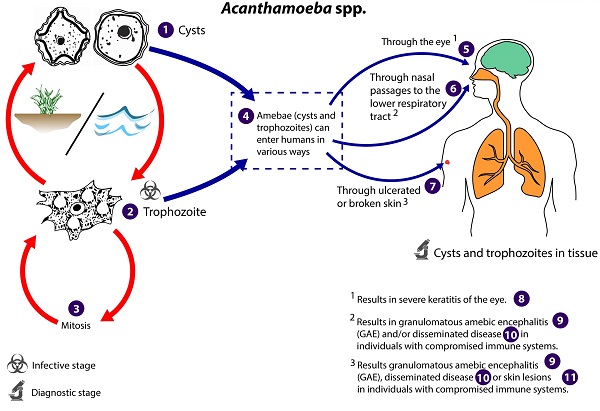Acanthamoeba - Life Cycle, Pathogenesis, Pathology, Host Immunity, Reservoir, Transmission
Life Cycle of Acanthamoeba
Acanthamoeba infection is acquired by inhalation of aerosol or dust containing the cysts or trophozoites or through broken skin
after reaching the lower respiratory tract in the lungs, the trophozoites invade the Central Nervous System through the blood circulation
while dividing by binary fission in the CNS, the nuclear membrane disappears
the trophozoites then invade the posterior fossa, basal ganglia, base of the cerebral hemisphere, and cerebellum

Fig: Acanthamoeba life cycle (Source: CDC)
Pathogenesis, Pathology of Acanthamoeba
Acanthamoeba spp. infects the brain, eyes, skin, and lungs where they produce lesions. The invading amoebae lyse the host cells by:
enzyme-mediated contact-mediated lysis of cellular parts of the cells
by the process of trogocytosis, the ingestion of cytoplasm of a cell
In the brain, the parasite (both cysts and trophozoites) produces patchy, chronic, sub-acute lesions of granulomatous encephalitis. Such granulomatous lesions are found in the cerebellum, mid-brain, and brain stem and consist of focal edema with areas of necrosis and hemorrhage.
In cases where Acanthamoeba spp. has infected the skin, nodular and ulcerative lesions along with subcutaneous inflammation and formation of abscess are present
Acanthamoeba spp. reaches the cornea of the eye through minor abrasions made due to contact lenses or external injury. Syndromes in such cases include inflammation with an epithelial defect, formation of pus, or hypopyon. If the infection progresses, it may lead to bulging of the posterior membrane and subsequent perforation releasing aqueous humor.
Host Immunity of Acanthamoeba
In healthy individuals, the immune system provides protection from granulomatous amoebic encephalitis while in patients with impaired humoral and cell-mediated immune systems, the person is more susceptible to Acanthamoeba spp. Infection.
Epidemiology of Acanthamoeba
occurs worldwide
Reservoir, Source, Transmission of Acanthamoeba
The source of infection and transmission includes inhalation of air, aerosol, dust, or through broken skin for Granulomatous amebic encephalitis (GAE).
In cases of Acanthamoeba keratitis, the source of infection and transmission is contaminated water used to clean contact lenses and homemade saline solutions. Prolonged use of contact lenses may also cause infection.
Prevention, Control of Acanthamoeba
it is difficult to control GAE as the parasites are ubiquitous in air, soil, and water
Acanthamoeba keratitis can be prevented by proper cleaning and disinfecting of contact lenses and by avoiding wearing contact lenses while swimming